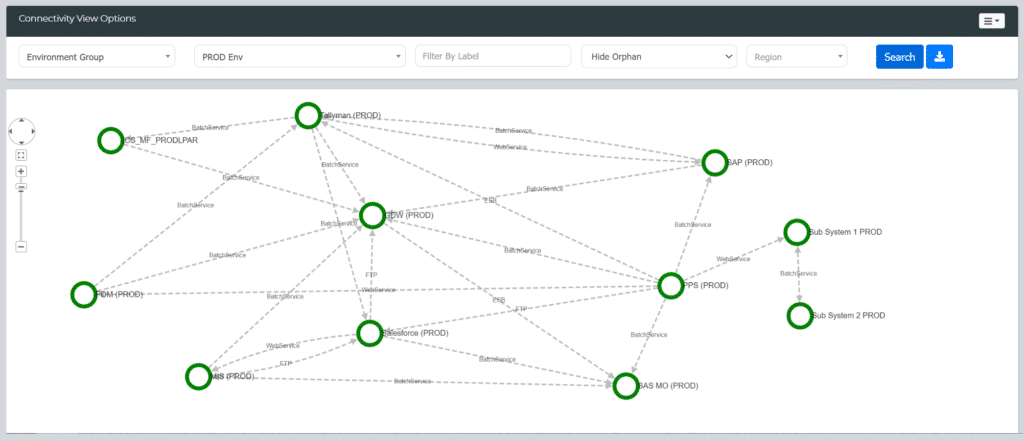
In today’s complex IT environments, understanding how applications interact with each other and the underlying infrastructure is crucial. Application Dependency Mapping (ADM) provides this insight, making it an essential tool for IT professionals. This guide explores what ADM is, why it’s important, and how to effectively implement it in your organization.
What Is Application Dependency Mapping?
Application Dependency Mapping is the process of identifying and documenting the relationships and dependencies between applications, services, and their underlying hardware and network infrastructure. It creates a visual representation of how applications are interconnected, which is invaluable for both daily operations and strategic planning.
Example: Imagine a CRM system that relies on a database server and an email gateway to function. ADM would help document these relationships, ensuring any changes to the email gateway are assessed for potential impacts on the CRM system.

Why Is Application Dependency Mapping Important?
ADM is vital for several reasons:
- Risk Management: It identifies critical dependencies that could lead to failures if disrupted.
- Change Management: It helps evaluate the potential impact of changes within the IT environment, reducing downtime and negative outcomes.
- Optimization: It assists in identifying redundant resources and bottlenecks, enabling more efficient use of IT assets.
Key Components of Application Dependency Mapping
Understanding the components of ADM helps in effectively mapping dependencies:
- Applications: What software applications are used, and how are they configured?
- Dependencies: What are the interdependencies between applications? This includes software, hardware, and network dependencies.
- Infrastructure: What hardware and network resources do these applications depend on?
- Data Flow: How does data move between components? This is crucial for identifying potential bottlenecks and points of failure.
Benefits of Application Dependency Mapping
The implementation of ADM offers several benefits:
- Operational Efficiency: Quick identification and resolution of issues due to a clear understanding of dependencies.
- Strategic Planning: Facilitates infrastructure upgrades, migrations, and disaster recovery planning.
- Financial Savings: Reduces costs by identifying underutilized resources and optimizing capacity planning.
Methods for Creating Application Dependency Maps
There are two main methods for creating dependency maps:
- Manual Mapping: Involves manually documenting dependencies, often using spreadsheets or simple diagrams. While cost-effective, it is time-consuming and prone to errors.
- Automated Tools: Software solutions that automatically discover and map dependencies.
- Commercial Solutions: These often offer comprehensive features and support but at a higher cost.
- Open-Source Solutions: Can be cost-effective but may require more customization and have less support.
Tools and Technologies
Several tools can aid in ADM, including the Enov8 Environment & Release Manager. This tool provides features that automate and simplify the creation of application dependency maps, offering clear visibility into complex IT environments. By integrating such tools, organizations can maintain accurate and up-to-date dependency maps, essential for effective IT management.
The Importance of ADM in Application Portfolio Management (APM) and IT Environment Management
ADM’s Role in APM
ADM is not just a technical necessity; it’s a strategic asset in Application Portfolio Management (APM). By providing a clear map of application dependencies, ADM enables organizations to make informed decisions about application maintenance, modernization, and rationalization. It helps determine which applications are critical to business processes, which are outdated and need replacement, and how changes within the portfolio might impact business operations. This strategic alignment with business goals ensures that IT investments contribute directly to business outcomes, enhancing ROI and compliance.
ADM’s Contribution to IT Environment Management
In the realm of IT & Test Environment Management, ADM plays a crucial role by mapping applications to their respective hardware and network infrastructures. This mapping is essential for effective capacity planning, performance monitoring, and incident management. By understanding how applications interact with the physical and virtual environments, IT teams can optimize resource allocation, plan for scalability, and ensure high availability and disaster recovery more effectively. ADM also aids in root cause analysis during outages, helping to quickly identify and address the impacted services.
ADM as a Bridge between Platforms, Business, and SDLC
ADM can also be leveraged to connect platforms directly to business outcomes and the Software Development Life Cycle (SDLC). By mapping out how specific applications and platforms support business functions, organizations can prioritize development and maintenance efforts according to business needs. This ensures that IT development aligns with strategic business objectives, improving both development efficiency and project outcomes. In environments where continuous integration/continuous deployment (CI/CD) practices are in place, ADM provides the necessary visibility to manage these complex interactions and dependencies, thus supporting a more agile and responsive SDLC.
Challenges in Application Dependency Mapping
Despite its benefits, ADM presents challenges:
- Complexity: Modern IT environments are complex and dynamic, making mapping difficult.
- Data Accuracy: Maintaining up-to-date and accurate ADM data requires constant vigilance, especially in environments with frequent changes.
- Scaling: As organizations grow, the scale of ADM efforts must grow too, which can be a significant challenge without automated tools.
Best Practices in Application Dependency Mapping
To overcome challenges and maximize the effectiveness of ADM, consider the following best practices:
- Regular Updates: Keep dependency maps updated to reflect the current IT environment.
- Stakeholder Involvement: Ensure that all relevant stakeholders are involved in the ADM process to provide insights and validate information.
- Use of Tools: Leverage automated tools to enhance accuracy and efficiency in creating and maintaining dependency maps.
Conclusion
Application Dependency Mapping is a critical process that supports numerous IT management and governance activities. By understanding and implementing ADM effectively, organizations can significantly improve their IT operations, enhance risk management, and optimize resource utilization. As IT environments continue to evolve, ADM remains a foundational practice that provides clarity and control in a complex digital landscape.
